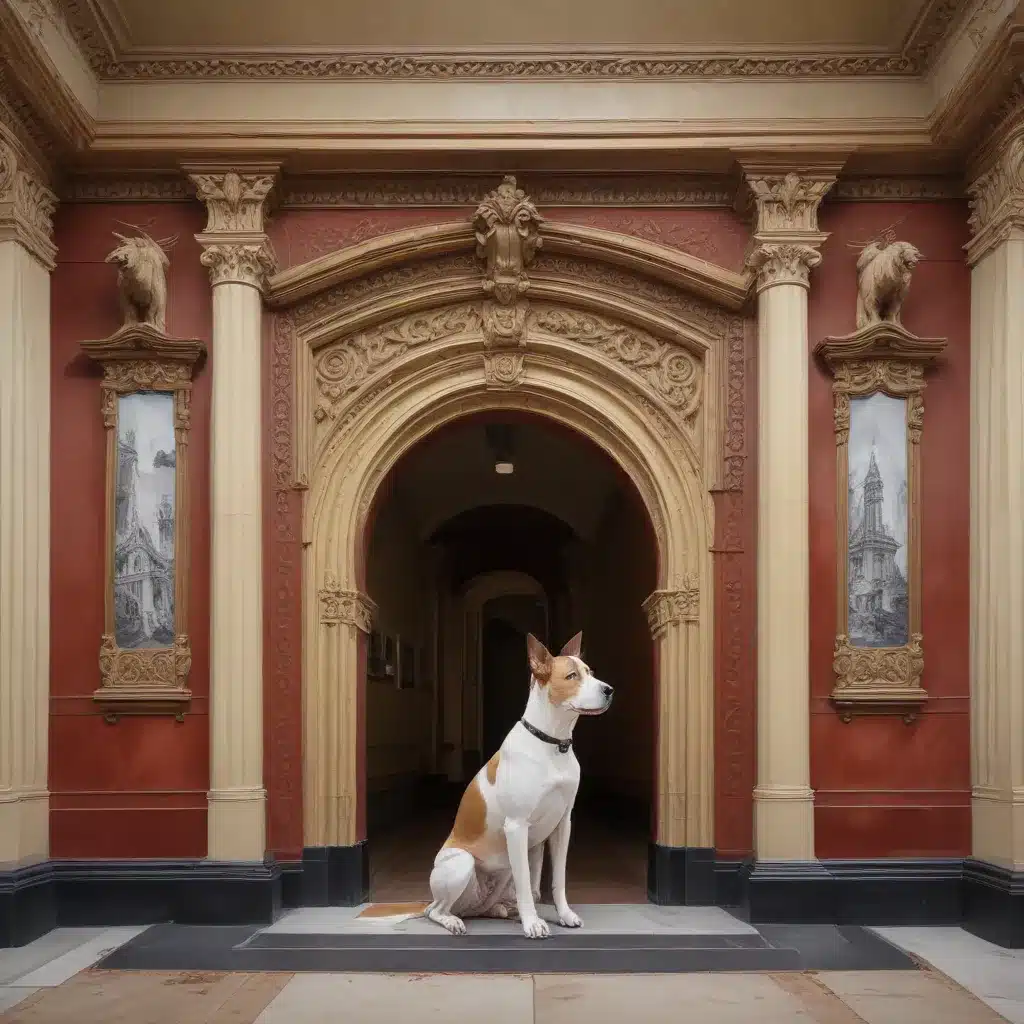
The Picturesque Perspective
The concept of the ‘picturesque’ has long captivated artists, architects, and designers, offering a unique lens through which to view and interpret the built environment. This artistic perspective, rooted in 18th-century aesthetic theory, celebrates the irregular, the asymmetrical, and the visually striking – qualities that can be just as readily found in the architectural landscape as in natural scenery.
As seasoned artists, we can harness the power of the picturesque to infuse our pet portraits with a dynamic sense of place. By observing the interplay of light, texture, and form in our surroundings, we can translate the essence of a building or cityscape into a captivating backdrop for our animal subjects. This approach not only breathes life into our compositions but also invites the viewer to engage with the painting on a deeper level, experiencing the rich tapestry of the built environment alongside the beloved pet.
Uncovering the Architectural Vernacular
The foundations of the picturesque in art and design can be traced back to the writings of influential theorists like William Gilpin and Uvedale Price, who championed the aesthetic qualities of ‘irregularity’ and ‘variety’ over the classical ideals of symmetry and balance. These thinkers recognized that the human eye was drawn to the unpolished, the asymmetrical, and the visually stimulating – qualities that were often found in the accidental forms of vernacular architecture.
As we set out to create our pet portraits, we can take inspiration from this rich tradition, observing the architectural vernacular that surrounds us and translating its distinctive features into our paintings. Whether it’s the weathered facade of a historic building, the whimsical angles of a modernist structure, or the intricate patterns of traditional craftsmanship, the built environment is a veritable treasure trove of picturesque inspiration.
Mastering the Malerisch: Painterly Techniques for Architectural Artistry
The German art historian Heinrich Wölfflin famously used the term ‘malerisch’ to describe the ‘painterly’ qualities that distinguished the Baroque style from the more linear and geometric forms of the Renaissance. This concept of the ‘painterly’ – with its emphasis on the expressive use of color, texture, and brushwork – is just as essential to capturing the essence of architecture in our pet portraits.
By embracing a malerisch approach, we can infuse our paintings with a vibrant, dynamic energy that echoes the visual richness of the built environment. Techniques like loose, gestural brushwork, layered glazes, and a focus on atmospheric effects can help us translate the character of a building or urban space into a compelling backdrop for our animal subjects. Experimentation with materials, from impasto oil paints to fluid acrylics, can further enhance the tactile, sculptural qualities of our architectural elements.
Crafting Compositional Harmony
As we integrate architectural motifs into our pet portraits, it’s crucial to maintain a cohesive and harmonious composition. The picturesque aesthetic celebrates the unexpected and the irregularity, but this must be balanced with a strong sense of visual unity to ensure the painting’s overall effectiveness.
Techniques like the strategic placement of the pet subject, the careful framing of the architectural elements, and the thoughtful use of color and value can all contribute to a composition that seamlessly blends the animal and the built environment. By considering the interplay of positive and negative space, the flow of the viewer’s gaze, and the rhythmic interplay of shapes and patterns, we can craft paintings that invite the viewer to explore the dynamic relationship between our beloved pets and their surrounding landscape.
Channeling the Spirit of Place
Ultimately, the true power of infusing our pet portraits with architectural elements lies in our ability to capture the unique ‘spirit of place’ – the distinctive character and atmosphere that permeates a particular setting. Whether we’re depicting the stately grandeur of a historic manor, the whimsical charm of a quaint village, or the bold modernity of a sleek urban landscape, our paintings should evoke a tangible sense of the location’s unique identity.
By carefully observing the nuances of light, color, and texture that define a space, we can imbue our pet portraits with a palpable sense of place. The interplay of warm and cool tones, the play of shadows and highlights, the rhythm of architectural details – these elements all contribute to the creation of a distinctive visual language that speaks to the viewer on a deeper, more emotive level.
Embracing the Experimental
As we explore the intersection of pet portraiture and architectural artistry, it’s important to approach our practice with a spirit of experimentation and a willingness to take creative risks. The picturesque aesthetic encourages a playful, open-minded approach to composition and technique, inviting us to step outside the confines of traditional portraiture and embrace the unexpected.
Through ongoing exploration and a commitment to expanding our artistic toolbox, we can uncover new and innovative ways to integrate architectural elements into our pet paintings. Whether it’s experimenting with mixed media, incorporating found objects, or pushing the boundaries of abstraction, the possibilities are endless. By embracing a spirit of adventure and a passion for discovery, we can unlock new avenues of artistic expression and create paintings that captivate and inspire.
Conclusion: Elevating the Everyday
By harnessing the power of the picturesque, we as artists can elevate the everyday into the extraordinary, transforming the familiar built environment into a vibrant and dynamic stage for our beloved pet subjects. Through a mastery of malerisch techniques, a keen eye for compositional harmony, and a deep appreciation for the spirit of place, we can craft pet portraits that not only capture the unique personalities of our animal companions but also immerse the viewer in a rich, multifaceted world of architectural artistry.
As we continue to push the boundaries of our craft, let us embrace the transformative potential of the picturesque, celebrating the irregular, the asymmetrical, and the visually striking – and in doing so, create paintings that captivate, inspire, and leave a lasting impression on all who behold them.